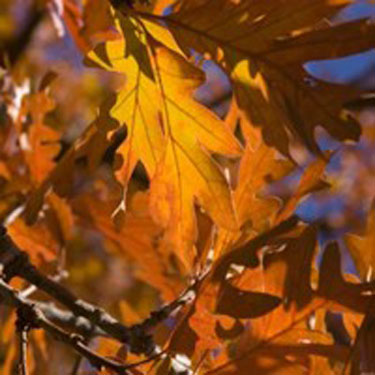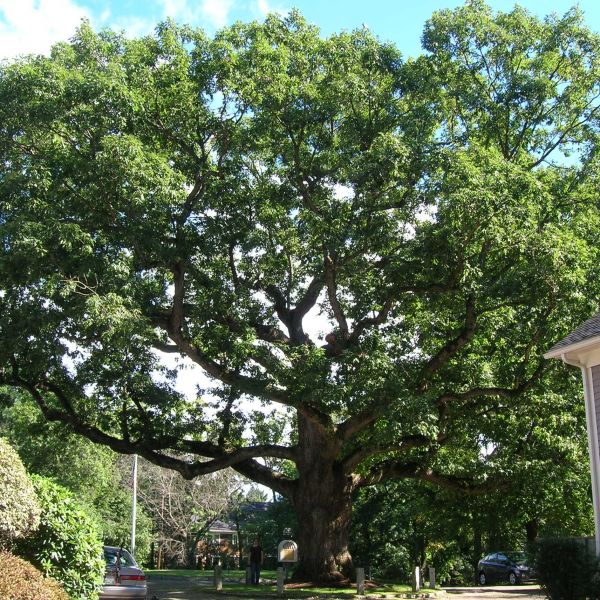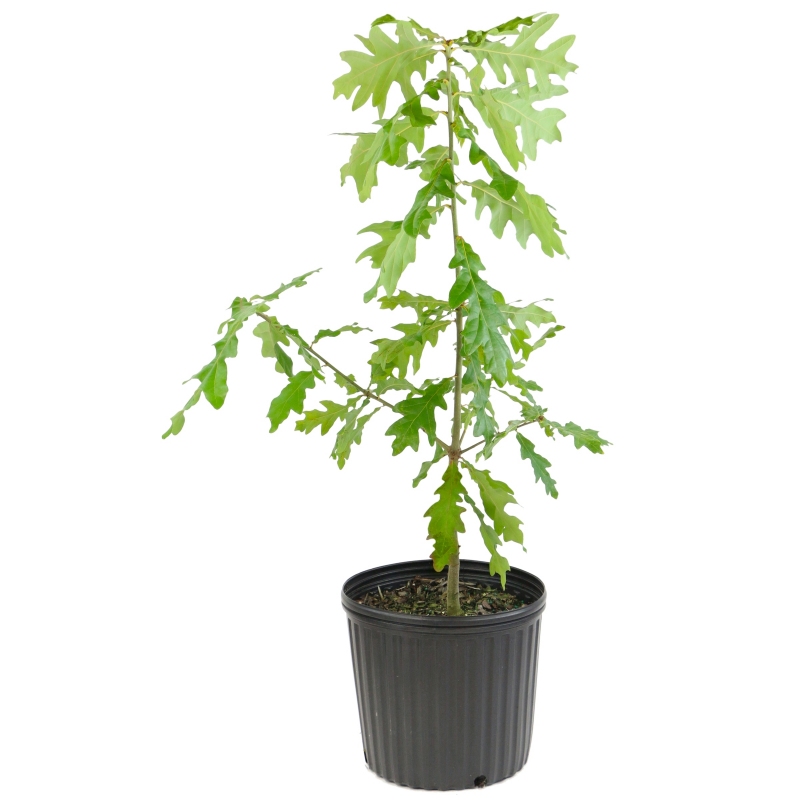



White Oak
Quercus alba
88 reviews
White Oak
Quercus alba
88 reviews
1 Gallon
We are sorry, product is currently out of stock due to seasonal availability. Please check the "Related plants available in your area" section below
Not just beautiful - intentionally selected by ShrubHub's 3D landscape design team to fit real-world spaces and maximize yard potential.
Why White Oak?
White oak (Quercus alba) is a deciduous tree found mainly in eastern North America. It is a long-lived tree, known to survive over 400 years, and can grow up to 100 feet tall. The wood of white oak is highly valued for its strength, durability, and attractive grain pattern, making it a popular choice for furniture, flooring, and barrels for aging wine and whiskey. The leaves of white oak are also important to wildlife, providing food for 522 species of butterflies and moths.
Sunlight
White Oak trees (Quercus alba) require full sun exposure for optimal growth. They need at least 6 to 8 hours of direct sunlight daily to thrive and develop properly.
Watering
White Oak trees have moderate watering requirements. They prefer moist soil but can tolerate periods of drought once established. It is important to water deeply and infrequently, allowing the soil to partially dry out before watering again.
Fertilizing
White Oaks generally do not require any additional fertilizer. They can thrive in a variety of soil types and are often able to obtain sufficient nutrients from the soil naturally.
The White Oak Tree is a kind of large, native oak tree to North America. The massive stature, stunning foliage, and high-quality wood of this tree have made it a cultural symbol.
While the White Oak Tree is a relatively low-maintenance tree, it does require occasional pruning to maintain its shape and remove dead or damaged branches. It is generally resistant to pests and diseases, and it can tolerate a wide range of growing conditions.
White Oak is adaptable to a wide range of growing conditions, including full sun to partial shade and a variety of soil types. It prefers well-drained soil that is rich in organic matter, but it can tolerate dry or wet soil conditions as well.
This tree is a large and impressive specimen that can reach heights of up to 80-100 feet tall and 60-80 feet wide. It has a broad, spreading shape that makes it a great choice for providing shade and a stunning focal point in larger landscapes.
White Oak has attractive, dark green foliage that turns a yellow to golden brown color in the fall. The foliage is arranged in a unique, lobed pattern along its spreading branches, giving the tree a full and lush appearance.
White Oak is a massive tree with beautiful leaves that also yields acorns that are both enormous and valuable. Aside from being utilized in the manufacturing of flour and other foods, acorns are a vital resource for wildlife.
White oak is a majestic tree that will last for many years and add beauty to any garden. Its remarkable size, gorgeous foliage, and precious acorns make it a fantastic option for shading and a stunning focal point in big landscapes.
Plant Information:
| Botanical Name: | Quercus alba |
| USDA Zones: | 3 - 9 |
| Water: | Low Once Established |
| Exposure: | Full Sun |
| Soil Needs: | Well Drained |
| Mature Height: | 60 - 90 feet |
| Mature Spread: | 50 - 90 feet |








Pollination Info
FAQ
White Oak (Quercus alba) Frequently Asked Questions:
Q: What is White Oak?
A: White Oak (Quercus alba) is a species of oak tree native to North America, found in eastern and central regions of the United States and Canada. It is a long-lived, deciduous tree that can grow up to 100 feet tall, with a broad, rounded canopy and deeply furrowed bark.
Q: What are the uses of White Oak?
A: White Oak is valued for its strong, durable wood, which is used for a variety of purposes including flooring, furniture, barrels, and shipbuilding. The acorns produced by White Oak are also an important food source for wildlife.
Q: How do you identify a White Oak tree?
A: White Oak trees have dark gray bark with deep furrows, and their leaves are lobed with rounded tips and a smooth surface. The acorns produced by White Oak have a characteristic flattened cap and are relatively large compared to other oak species.
Q: When do White Oak trees produce acorns?
A: White Oak trees typically begin producing acorns when they are around 20 years old, with peak production occurring between 50 and 80 years of age. The timing of acorn production can vary depending on environmental factors such as temperature and rainfall.
Q: Is White Oak a good tree to plant for landscaping?
A: White Oak is a great species to plant for landscaping, as it provides shade, attracts wildlife, and has a beautiful fall color display. However, it is important to note that White Oak trees can become quite large over time and may not be suitable for small yards or urban environments.
Q: How do you care for a White Oak tree?
A: White Oak trees generally require little maintenance once established, but young trees should be watered regularly and protected from deer and other animals that may eat the bark or foliage. Pruning is generally not necessary, but dead or damaged branches should be removed as needed.
Q: What pests and diseases are common to White Oak?
A: White Oak trees are susceptible to a number of pests and diseases, including oak wilt, powdery mildew, and gypsy moth caterpillars. Regular monitoring for signs of infestation and prompt treatment if detected can help protect White Oak trees from damage.
Planting & Care
Planting & Care for White Oak (Quercus alba)
Planting:
- White oaks prefer full sun and well-draining soil. Choose a planting location that meets these requirements.
- Plant your white oak in the fall or early spring when the tree is dormant. This will give it time to establish roots before hot weather arrives.
- Dig a hole that is slightly larger than the root ball of the tree. Make sure the hole is deep enough so that the top of the root ball is level with the ground.
- Backfill the hole with soil, making sure to tamp down the soil around the roots to remove any air pockets.
- Water your white oak thoroughly after planting.
Care:
- White oaks typically require little maintenance once established.
- Water your white oak regularly during the first few years after planting to help it establish strong roots.
- Mulch around the base of the tree to help retain moisture and keep weeds at bay. Make sure not to pile the mulch up against the trunk of the tree.
- Prune your white oak in late winter or early spring to remove any dead or damaged branches.
- Fertilize your white oak once a year in the early spring using a slow-release fertilizer. Follow the manufacturer's instructions for application.
Pests & Diseases:
- White oaks are generally healthy trees, but they can be susceptible to oak wilt and other diseases. Monitor your tree for any signs of disease, such as wilted leaves or discoloration.
- Look for signs of insect infestation, such as holes in the leaves or branches. Common pests that attack white oaks include gypsy moths, oak leafrollers, and oak borers.
- Consult a professional arborist if you suspect your white oak has an insect infestation or disease.
Note: White oaks are slow-growing trees and may take several years to become established. Be patient and provide the proper care to ensure a healthy, long-lived tree.
Check Out These Verified Customer Reviews:
Customer Reviews
4.7 out of 5 based on 88 reviews
Thank you! Your review has been submitted.
I recently purchased a white oak coffee table from White Oak and I am very impressed with the item quality. The website was easy to navigate and the shipment arrived on time.
Items arrived earlier than expected, very happy with the fast shipment.
Well-packaged, arrived quickly and in perfect condition.
Item has been added to your cart.


